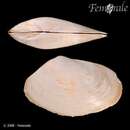fi
nimet breadcrumb-navigoinnissa


Paphies ventricosa – oder Toheroa nach der Bezeichnung für die Art in der Sprache der Māori – ist eine große Muschel aus der Familie der Mesodesmatidae, die in Neuseeland endemisch ist. Sie lebt sowohl an der Küste der Nordinsel als auch der der Südinsel, ihr hauptsächlicher Lebensraum ist jedoch die Westküste der Nordinsel. Sie bevorzugt breite Sandstrände mit ausgedehnten Sanddünen, die Süßwasser einschließen, das durch den Sand ins Meer sickert und dort das Wachstum von Diatomeen und anderem Plankton fördert.
Die Toheroa ist eine große Muschel mit einer weißen, länglichen Schale mit einer Aufwölbung in der Mitte. Die Toheroa war ein sehr beliebtes Nahrungsmittel, das oft zu Suppe verarbeitet wurde, die auch internationale Bekanntheit erlangte. Nach Überfischung der Bestände in den 1950er und 1960er Jahren wurde das Sammeln der Muscheln stark beschränkt.
Die Schale der Muschel ist bis zu 117 mm lang, 81 mm breit und 38 mm dick.
Paphies ventricosa – oder Toheroa nach der Bezeichnung für die Art in der Sprache der Māori – ist eine große Muschel aus der Familie der Mesodesmatidae, die in Neuseeland endemisch ist. Sie lebt sowohl an der Küste der Nordinsel als auch der der Südinsel, ihr hauptsächlicher Lebensraum ist jedoch die Westküste der Nordinsel. Sie bevorzugt breite Sandstrände mit ausgedehnten Sanddünen, die Süßwasser einschließen, das durch den Sand ins Meer sickert und dort das Wachstum von Diatomeen und anderem Plankton fördert.
Die Toheroa ist eine große Muschel mit einer weißen, länglichen Schale mit einer Aufwölbung in der Mitte. Die Toheroa war ein sehr beliebtes Nahrungsmittel, das oft zu Suppe verarbeitet wurde, die auch internationale Bekanntheit erlangte. Nach Überfischung der Bestände in den 1950er und 1960er Jahren wurde das Sammeln der Muscheln stark beschränkt.
Die Schale der Muschel ist bis zu 117 mm lang, 81 mm breit und 38 mm dick.
Paphies ventricosa, or toheroa (a Māori word meaning "long tongue"),[1] is a large bivalve mollusc of the family Mesodesmatidae, endemic to New Zealand.
It is found in both the North and South Islands, but the main habitat is the west coast of the North Island. The best grounds are wide fine-sand beaches where there are extensive sand-dunes, enclosing freshwater, which percolates to the sea, there promoting the growth of diatoms and plankton.[2]
The toheroa is a very large shellfish with a solid white, elongated shell with the apex at the middle. Maximum length is 117 mm, height 81 mm, and thickness 38 mm.
Toheroa are a traditional food for Māori. Toheroa beds were resources that sometimes led to wars, and the shellfish was translocated across New Zealand using pōhā (kelp bags) made from southern bull kelp (Durvillaea poha).[3][4]
The toheroa has long been a popular seafood, often made into a greenish soup.[5] The soup became an international delicacy after the Royal Tour of Prince Edward in 1920, becoming popular in restaurants in New Zealand, the United Kingdom and Australia. An industry developed around toheroa, including large-scale canning factories.[4]
By the 1950s, toheroa populations had become over-exploited, and there has been a ban on harvesting (except for limited customary purposes) since 1979. However, numbers have not recovered since 1979, due to illegal poaching, poorly policed customary harvesting, vehicle driving on beaches, pollution, reduction in fresh water coming onto beaches, and gas bubble disease.[6]
Paphies ventricosa, or toheroa (a Māori word meaning "long tongue"), is a large bivalve mollusc of the family Mesodesmatidae, endemic to New Zealand.
Paphies ventricosa is een tweekleppigensoort uit de familie van de Mesodesmatidae.[1] De wetenschappelijke naam van de soort is voor het eerst geldig gepubliceerd in 1843 door Gray.
Bronnen, noten en/of referenties